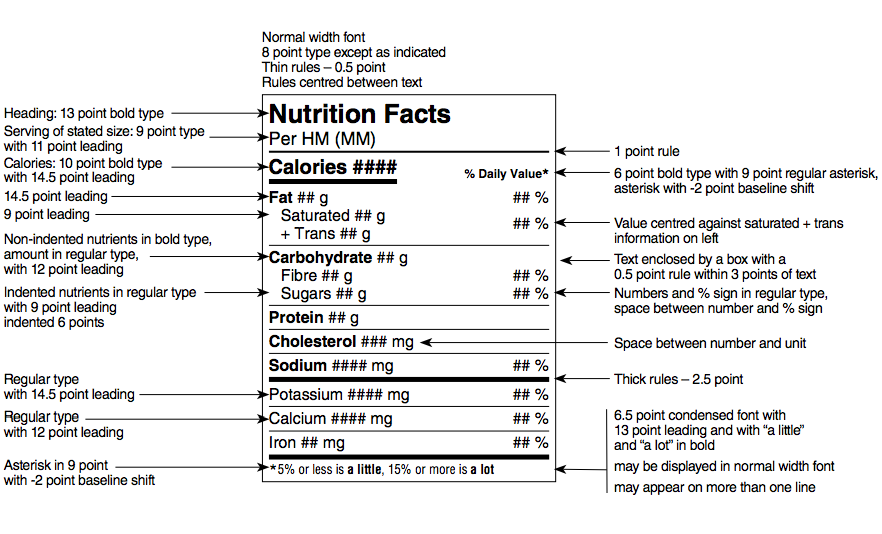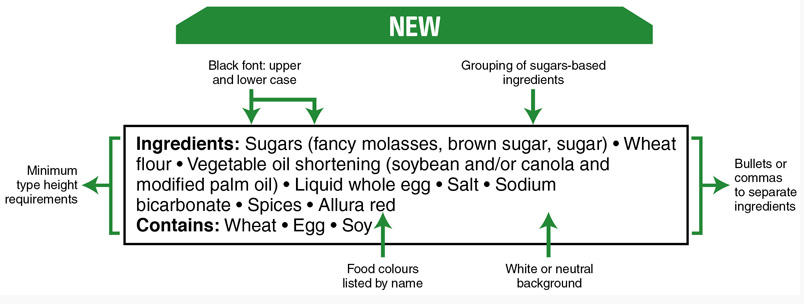New Food Labeling Rules in Canada
December 21, 2016
On December 14, 2016, Canada’s Minister of Health announced new food labeling rules informed by “science-based nutrition” and years of consultations with stakeholders and the Canadian public by the Canadian Food Inspection Agency.
These changes, which include updates to the Nutrition Facts Table, new rules for listing ingredients, and changes to standardized serving sizes, will be mandatory as of 2021. This gives the food industry five years to comply with new regulations, although Canadians could start seeing new labels on grocery store shelves as early as 2017.
Changes to the Nutrition Facts Table
Changes to the Nutrition Facts Table are intended to:
- Make serving sizes more consistent and realistic.
- Help Canadians better understand the nutritional content of their food choices.
- Draw more attention to the calorie and sugar content of packaged foods.
In addition, new Daily Values for nutrients have been established. These updated values can be found on the Government of Canada website in the Table of Daily Values, a new document.

Source: Government of Canada
Serving Sizes
The new Nutrition Facts Table requires standardized serving sizes that have been updated to allow Canadians to more easily compare similar types of food (e.g. two different brands of yogurt). The new serving size reference amounts can be found in the Table of Reference Amounts for Food on the Government of Canada website.
If a food product is sold in a single-serving container and the container holds up to 200% of the reference amount for that food, the serving size must be equivalent to the entire contents of the container.
If a food comes in pieces (such as crackers or cookies) or is divided before eating (such as a frozen pizza), the serving size must be shown as either the number of pieces or a fraction of the food (e.g. 1/4 pizza).
Calories
Calories must be printed in larger type with a bold underline (see image above).
Sugars
In addition to new rules for sugars in a food package’s ingredients list (explained below), a Daily Value has been established for sugars and must be listed alongside the metric measurement of total sugar content in grams.
Nutrients
Nutrient content must be shown both in milligrams (mg) and Daily Value percentage, and the nutrients which are mandatory to list on the NFT have changed. Vitamins A and C are no longer mandatory to list, as deficiencies in these vitamins are rare. Now, the NFT must show potassium content along with calcium and iron in both milligrams and Daily Value percentage.
Daily Value Footnote
Previously, no Daily Value footnote was required. Now, the NFT must show the following Daily Value footnote:
5% or less is a little / 5% ou moins c’est peu
15% or more is a lot / 10% ou plus c’est beaucoup
This new footnote is intended to provide an easy way for Canadian consumers to understand the nutritional content of their food choices.
List of Ingredients
The way ingredients must be listed has not changed substantially, but a few important new rules have been introduced.

Source: Government of Canada
Grouping Sugar Ingredients
All sugar-based ingredients must now be grouped together in the ingredients list. Previously, various types of sugars could be listed separately by weight. This new rule is intended to give Canadians a more accurate idea of how much sugar their food contains. Sugars must be listed in order of weight as a total, and then in brackets showing the sources of sugar.
Name of Food Color
Food colors must be identified by name (e.g. Tartrazine) rather than just the word “color”.
Text & Print Requirements
All ingredients must be printed in black against a white or neutral background. Each ingredient must be printed with (only) its initial letter capitalized, and ingredients must be separated by bullet points or commas. There is a minimum height requirement equivalent to 6-point type in sans serif fonts, except when the label carries an NFT with nutrients shown in 8-point type. In this case, the minimum type height for the ingredients list is 8-point type in sans serif fonts.
Food Allergens & Gluten Sources
Allergens and sources of gluten must still be listed. If a “Contains” statement is used, it must follow the same format and conventions as the rest of the ingredients list. If the ingredients list is contained in a border or other lines, the “Contains” statement must be within the same border.
New Health Claim
A new health claim about reducing the risk of heart disease is allowed for certain fruit and vegetable products, including fresh, frozen, or canned fruits and vegetables. There are certain exclusions, including potatoes, yams, plantains, olives, fruit juice, or products containing more than 0.5% alcohol.
The claim must read:
A healthy diet rich in a variety of vegetables and fruit may help reduce the risk of heart disease.
For more information about qualifying products, click here to read the summary of Health Canada’s assessment of the new claim.
Project Central Knows Labeling Rules
Changing regulations in Canada and the United States are just one of many things you need to keep track of when designing or redesigning your packaging. Take advantage of Emmerson Packaging’s 60+ years of expertise in flexible packaging by letting your Project Coordinator from Project Central do the heavy lifting for your next project. Click here to see what Project Central can do for you!

